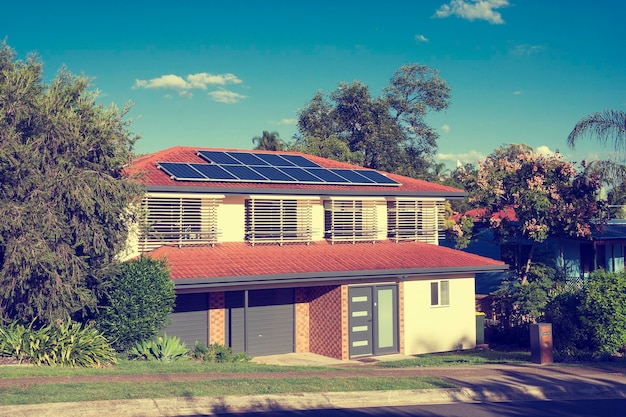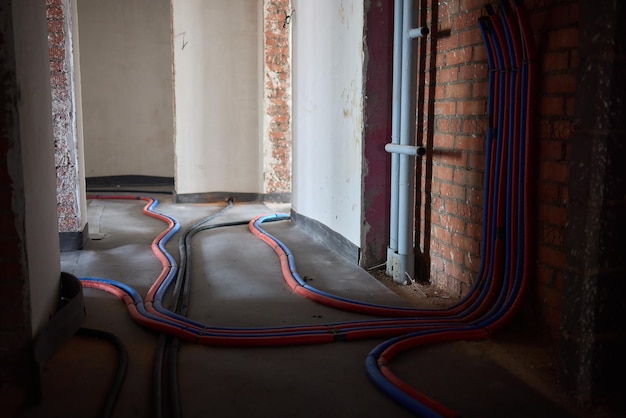Federal Tax Credits for Renewable Energy: Homeowner’s Guide 2026

Federal Tax Credit Expansion for Renewable Energy: What Homeowners Need to Know Before 2026 offers significant financial incentives for homeowners investing in renewable energy systems, covering up to 30% of the cost for solar panels, wind turbines, and geothermal heat pumps installed before 2033, with specific guidelines on eligibility and claiming procedures.
Are you a homeowner looking to reduce your carbon footprint and save money on energy bills? The Federal Tax Credit Expansion for Renewable Energy: What Homeowners Need to Know Before 2026 can provide significant financial incentives for installing renewable energy systems. Let’s explore how you can benefit from these credits.
Understanding the Renewable Energy Tax Credit
The Investment Tax Credit (ITC), often referred to as the federal solar tax credit, is a substantial incentive for homeowners who invest in renewable energy technologies. This credit effectively lowers the upfront costs of installing systems like solar panels, wind turbines, and geothermal heat pumps, making these environmentally friendly options more financially accessible.
What Does the Tax Credit Cover?
The tax credit covers a significant portion of the cost associated with installing renewable energy systems. This includes not only the cost of the equipment itself but also the labor costs for installation, permitting fees, and inspection costs. Here’s a more detailed breakdown:
- Solar Panels: Covers the cost of purchasing and installing solar panels on your home.
- Wind Turbines: Includes small wind turbines used to generate electricity for your residence.
- Geothermal Heat Pumps: Covers systems that tap into the Earth’s natural heat to provide heating and cooling.
- Fuel Cells: Though less common for residential use, fuel cells powered by renewable sources also qualify.
It’s essential to keep detailed records of all expenses related to your renewable energy project. This includes receipts for equipment purchases, invoices for installation services, and any other documentation that supports your claim for the tax credit.

Who is Eligible for the Tax Credit?
To be eligible for the renewable energy tax credit, you must meet specific criteria. Primarily, you must own the home where the renewable energy system is installed. This means you need to be the legal homeowner, whether it’s a single-family home, a condo, or a mobile home.
Furthermore, the renewable energy system must be new or being used for the first time. It cannot be a system that has been previously installed and used elsewhere. The system also needs to be located at your primary or secondary residence in the United States.
The renewable energy tax credit is a valuable tool for homeowners to invest in sustainable energy solutions. By understanding what the tax credit covers and who is eligible, you can make informed decisions about adopting renewable energy technologies for your home. This not only benefits the environment but also provides long-term cost savings on energy bills.
Key Changes in the Expansion
The expansion of the federal tax credit for renewable energy, particularly through the Inflation Reduction Act of 2022, brought about several key changes that significantly enhance the benefits for homeowners. One of the most notable changes is the extension of the tax credit at a higher rate.
Prior to the expansion, the tax credit was scheduled to decrease. However, the Inflation Reduction Act extended the 30% tax credit for renewable energy systems, ensuring homeowners can continue to receive substantial financial incentives for their investments in clean energy.
Increased Credit Rate
The Inflation Reduction Act not only extended the tax credit but also increased the credit rate to 30% for qualifying systems installed between 2022 and 2032. This consistent rate provides homeowners with a stable and predictable incentive, encouraging greater adoption of renewable energy technologies.
Extension of the Credit Timeline
Another critical change is the extension of the timeline for the tax credit. The 30% credit rate is available through 2032. In 2033, it decreases to 26%, and in 2034, it further decreases to 22%. After 2034 the residential energy credits will end unless Congress renews them. This extended timeline gives homeowners more time to plan and implement renewable energy projects, knowing they can still benefit from the credit.

Broader Eligibility Criteria
The expansion also broadened the eligibility criteria for certain types of renewable energy systems. For example, the requirements for energy efficiency standards that systems must meet have been updated, allowing more products to qualify for the credit.
These key changes in the expansion of the federal tax credit for renewable energy offer significant advantages for homeowners. The increased credit rate, extended timeline, and broader eligibility criteria make it more attractive and feasible for homeowners to invest in renewable energy systems. By understanding these changes, homeowners can make informed decisions and take full advantage of the available financial incentives.
The expansion of the federal tax credit for renewable energy represents a significant opportunity for homeowners to embrace sustainable energy solutions while also reducing their energy costs. The changes incorporated in this expansion provide increased financial incentives and a more supportive environment for investing in renewable technologies.
Eligible Renewable Energy Technologies
The federal tax credit for renewable energy covers a range of technologies designed to harness natural resources for electricity, heating, and cooling. Understanding which technologies are eligible is crucial for homeowners planning to invest in renewable energy systems.
Here are some of the primary renewable energy technologies that qualify for the federal tax credit:
- Solar Electric Property (Solar Panels): One of the most popular renewable energy options, solar panels convert sunlight into electricity. The tax credit covers the cost of the panels, installation, and related equipment.
- Solar Water Heaters: These systems use sunlight to heat water for domestic use, reducing the reliance on traditional water heaters.
- Geothermal Heat Pumps: Geothermal heat pumps utilize the Earth’s constant temperature to provide heating and cooling for homes.
- Small Wind Turbines: Homeowners can install small wind turbines to generate electricity. The tax credit applies to the turbine and the costs associated with installation.
- Fuel Cells: Fuel cells that generate electricity using hydrogen or other renewable fuels are also eligible for the tax credit.
Each of these technologies offers unique benefits and may be more or less suitable depending on factors such as location, climate, and energy needs. Homeowners should carefully consider their options and consult with professionals to determine the best renewable energy system for their homes.
Solar Photovoltaic (PV) Systems
Solar PV systems, commonly known as solar panels, are a widely adopted renewable energy technology for residential use. These systems convert sunlight directly into electricity.
The federal tax credit covers the total cost of installing a solar PV system, including the solar panels, inverters, wiring, mounting hardware, and labor costs. This makes solar PV systems an attractive investment for homeowners looking to reduce their electricity bills and carbon footprint.
Geothermal Heat Pumps
Geothermal heat pumps harness the Earth’s natural heat to provide heating and cooling. These systems are highly efficient and environmentally friendly.
The federal tax credit applies to the cost of installing a geothermal heat pump, including the heat pump itself, underground piping, and installation labor. Geothermal heat pumps offer a sustainable and cost-effective solution for climate control in homes.
Claiming the Tax Credit: A Step-by-Step Guide
Claiming the federal tax credit for renewable energy requires careful attention to detail and adherence to IRS guidelines. By following the steps below, homeowners can successfully claim the credit and receive the financial benefits they are entitled to.
- Keep Detailed Records: Accurate records are essential for claiming the tax credit. Keep receipts for all purchases related to the renewable energy system, including equipment, installation costs, and permitting fees.
- Fill Out IRS Form 5695: IRS Form 5695, Residential Energy Credits, is used to claim the tax credit. This form requires information about the type of renewable energy system installed, the total cost, and the amount of the credit being claimed.
- File with Your Federal Tax Return: After completing IRS Form 5695, include it with your federal tax return (Form 1040). Make sure to fill out all required information accurately.
By following these steps and keeping thorough records, homeowners can successfully claim the federal tax credit for renewable energy and enjoy the financial benefits of investing in clean energy technologies.
Gather Necessary Documents
Before you begin the process of claiming the tax credit, it’s essential to gather all necessary documents. This includes receipts, invoices, and any other documentation that supports the cost of your renewable energy system.
Complete IRS Form 5695
The next step is to complete IRS Form 5695, Residential Energy Credits. This form is specifically designed for claiming tax credits related to renewable energy and energy efficiency improvements.
File Form 5695 with Your Tax Return
Once you have completed IRS Form 5695, you need to file it with your federal tax return (Form 1040).
In summary, claiming the federal tax credit for renewable energy requires careful preparation and adherence to IRS guidelines. By gathering necessary documents, filling out IRS Form 5695 accurately, and filing it with your tax return, you can successfully claim the credit and receive the financial benefits of investing in renewable energy technologies.
Maximizing Your Tax Credit Benefits
To receive the most benefit from the federal renewable energy tax credit, it’s crucial to strategically approach your renewable energy investments and understand how to maximize your savings.
Here are some tips to help you maximize your tax credit benefits:
- Combine Energy Efficiency Upgrades: Consider combining your renewable energy investment with other energy efficiency upgrades, such as insulation, efficient windows, and smart thermostats.
- Plan Strategically: Plan your renewable energy projects to coincide with tax planning strategies.
- Consider Financing Options: Explore various financing options, such as loans and leases, to make renewable energy projects more affordable.
Combining Renewable Energy and Energy Efficiency
One effective way to maximize your tax credit benefit is to combine your renewable energy investment with other energy efficiency upgrades. The more you reduce your home’s energy consumption and greenhouse gas emissions, the more you’ll save and benefit the environment.
Timing Your Investment
The timing of your renewable energy investment can also impact the tax credit benefits you receive. If you anticipate having a higher tax liability in a particular year, it may be advantageous to complete your renewable energy project in that year to maximize the credit value.
Professional Consultation
Seeking professional advice from tax advisors, financial planners, and renewable energy experts can provide valuable insights and guidance for maximizing your tax credit benefits. These professionals can help you navigate the complexities of tax laws, financial planning, and renewable energy technologies.
Future of Renewable Energy Tax Credits
The future of renewable energy tax credits is promising, as governments worldwide recognize the importance of clean energy incentives. This is evidenced by the Inflation Reduction Act, which has significantly boosted the incentives for homeowners.
The future looks bright for renewable energy adoption and the continuation of tax incentives, with governments and organizations dedicated to ensuring a sustainable future.
- Potential for Further Expansion: There’s a possibility of further expanding the scope of renewable energy tax credits to include more technologies and applications.
- Increased Investment in Renewable Energy: The continuation of tax credits can drive increased investment in renewable energy technologies.
Long-Term Savings and Benefits
Investing in renewable energy systems offers long-term savings and a range of benefits for homeowners. From reducing energy bills to increasing property values, renewable energy systems provide lasting value.
Environmental Stewardship
By adopting renewable energy technologies, homeowners contribute to environmental stewardship and help mitigate climate change. Renewable energy sources produce clean, sustainable electricity, reducing the carbon footprint and reliance on fossil fuels.
| Key Point | Brief Description |
|---|---|
| ☀️ Solar Panels | Convert sunlight into electricity, reducing energy bills. |
| ♻️ Geothermal Systems | Use Earth’s natural heat for efficient heating and cooling. |
| 💰 Tax Credit Benefits | Claim up to 30% of renewable energy system costs. |
| 📅 Timeline | 30% credit through 2032; decreases in 2033 and 2034. |
Frequently Asked Questions
▼
The federal tax credit for renewable energy, also known as the Investment Tax Credit (ITC), is a financial incentive that reduces the upfront cost of installing renewable energy systems, such as solar panels, wind turbines, and geothermal heat pumps.
▼
The tax credit covers the cost of the renewable energy equipment, labor costs for installation, permitting fees, and inspection costs. It includes all costs for the system to be installed and functioning correctly.
▼
To claim the tax credit, you must keep detailed records of your expenses, complete IRS Form 5695, Residential Energy Credits, and file it with your federal tax return (Form 1040). Make sure the forms are accurate.
▼
If you don’t have sufficient tax liability in the installation year to use the entire credit, you can carry forward the remaining credit amount to future tax years. You can apply this to the next tax return year.
▼
Yes, many states offer additional incentives, rebates, and tax credits for renewable energy systems. Research state and local programs to maximize your savings by combining these with the IRS tax credit.
Conclusion
Understanding the Federal Tax Credit Expansion for Renewable Energy: What Homeowners Need to Know Before 2026 is essential for making informed decisions about your home’s energy solutions. This valuable incentive not only helps reduce upfront costs but also promotes environmental stewardship and long-term savings. By taking advantage of the available tax credits, homeowners can create a sustainable future while enjoying significant financial benefits.
